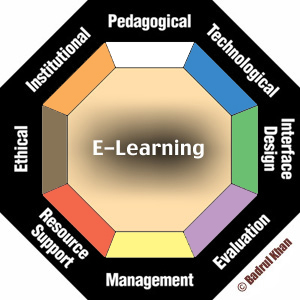Faculty Development Resources
This site is a supplement to the article Faculty Development For E-Learning: A Multi-Campus Community Of Practice (Cop) Approach (2012) by Janet Resop Reilly, Christine Vandenhouten, Susan Gallagher-Lepak, and Penny Ralston-Berg published in the Journal of Asynchronous Learning Networks (JALN).
Khan's Framework and Faculty Development

The Khan model is the Framework for E-learning which addresses online issues, strategies, and practices for flexible, open and distance learning environments. E-learning faculty development needs to consider the following areas: Pedagogical, Technological, Interface Design, Evaluation, Management, Resource Support, Ethical, and Institutional.
This Framework began with the question:
What does it take to provide the best and most meaningful flexible learning environments for learners worldwide?
-- Badrul H. Khan
Mouseover each dimension of the framework for a brief description.
More details are provided in the table below.
How can the framework be used to inform and enhance faculty development?
The eight dimension of the e-learning framework, a brief description, and sample survey questions are provided in the table below. The survey questions are intended to assess the presence of the framework dimensions at an institution as well as identify areas where adjustments to infrastructure, process, practice, or faculty development may be considered.
| Dimension | Description | Sample Survey Questions |
|---|---|---|
| Pedagogical | Addresses teaching and learning issues concerning content analysis, audience analysis, goal analysis, media analysis, design approach, organization and methods and strategies of e-learning environments. |
|
| Technological | Examines issues of technology infrastructure in e-learning environments including infrastructure planning, hardware and software. |
|
Interface Design | Encompasses overall look and feel of online programs including page and site design, content design, navigation, and usability testing. |
|
| Evaluation | Includes both assessment of learners and evaluation of the instruction and learning environment. |
|
| Management | Refers to the maintenance of the learning environment and distribution of information. |
|
Resource Support | Examines the online support and resources required to foster meaningful learning environments. |
|
| Ethical | Relates to social and political influence, cultural diversity, bias, geographical diversity, learner diversity, information accessibility, etiquette, and the legal issues. |
|
| Institutional | Concerned with issues of administrative affairs, academic affairs and student services related to e-learning. |
|
Adapted from: http://bookstoread.com/framework. Framework graphic is used with permission of Badrul Khan.
Additional Resources
Biography for Badrul Khan:
http://badrulkhan.com/